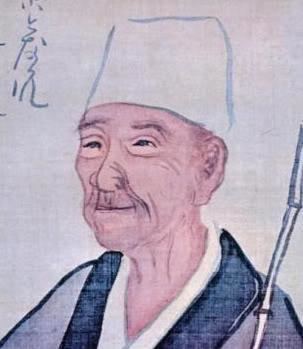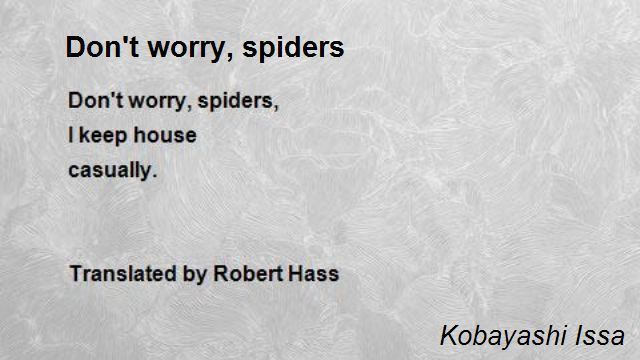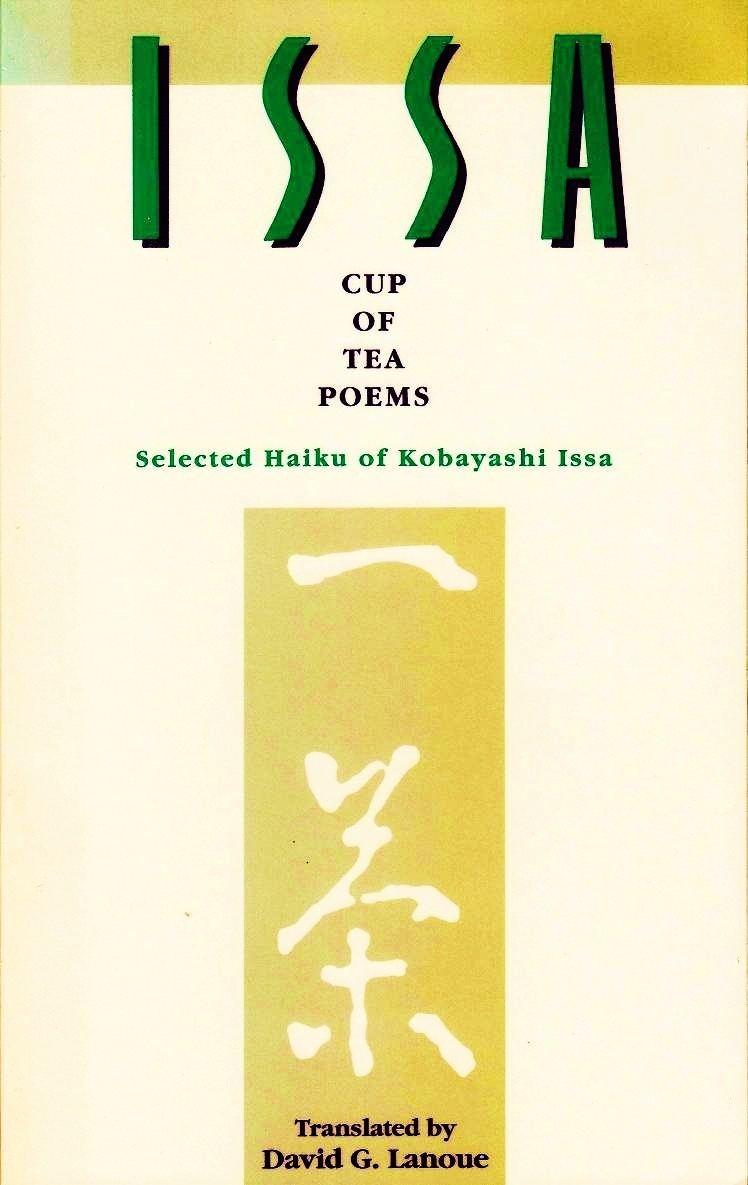Name Kobayashi Issa Siblings Senroku Parents Kuni, Yagobei | Children Sato Role Poet | |
 | ||
Spouse Kobayashi Yao (m. 1826–1828), Tanaka Yuki (m. 1824–1824), Kobayashi Kiku (m. 1814–1823) Books The spring of my life, The autumn wind, Issa's Best: Print Edition: a, The year of my life, Issa - cup‑of‑tea poems | ||
Poetry everywhere robert hass translation of selected haiku by kobayashi issa
Kobayashi Issa (小林 一茶, June 15, 1763 – January 5, 1828) was a Japanese poet and lay Buddhist priest of the Jōdo Shinshū sect known for his haiku poems and journals. He is better known as simply Issa (一茶), a pen name meaning Cup-of-tea (lit. "one [cup of] tea"). He is regarded as one of the four haiku masters in Japan, along with Bashō, Buson and Shiki — "the Great Four."
Contents
- Poetry everywhere robert hass translation of selected haiku by kobayashi issa
- the world of dew by kobayashi issa
- Biography
- Writings and drawings
- English translations
- References

Reflecting the popularity and interest in Issa as man and poet, Japanese books on Issa outnumber those on Buson and almost equal in number those on Bashō.

the world of dew by kobayashi issa
Biography

Issa was born and registered as Kobayashi Nobuyuki (小林 信之), with a childhood name of Kobayashi Yatarō (小林 弥太郎), the first son of a farmer family of Kashiwabara, now part of Shinano-machi, Shinano Province (present-day Nagano Prefecture). Issa endured the loss of his mother, who died when he was three. Her death was the first of numerous difficulties young Issa suffered.

He was cared for by his grandmother, who doted on him, but his life changed again when his father remarried five years later. Issa's half-brother was born two years later. When his grandmother died when he was 14, Issa felt estranged in his own house, a lonely, moody child who preferred to wander the fields. His attitude did not please his stepmother, who, according to Lewis Mackenzie, was a "tough-fibred 'managing' woman of hard-working peasant stock."

He was sent to Edo (present-day Tokyo) by his father one year later to eke out a living. Nothing of the next ten years of his life is known for certain. His name was associated with Kobayashi Chikua (小林 竹阿) of the Nirokuan (二六庵) haiku school, but their relationship is not clear. During the following years, he wandered through Japan and fought over his inheritance with his stepmother (his father died in 1801). He wrote a diary, now called Last Days of Issa's Father.

After years of legal wrangles, Issa managed to secure rights to half of the property his father left. He returned to his native village at the age of 49 and soon took a wife, Kiku. After a brief period of bliss, tragedy returned. The couple's first-born child died shortly after his birth. A daughter died less than two-and-a-half years later, inspiring Issa to write this haiku (translated by Lewis Mackenzie):


Issa married twice more late in his life, and through it all he produced a huge body of work.
A third child died in 1820. Then Kiku fell ill and died in 1823. "Ikinokori ikinokoritaru samusa kana" (生き残り生き残りたる寒さかな) [Outliving them,/Outliving them all,/Ah, the cold!] was written when Issa's wife died, when he was 61.
As a big fire swept the post station of Kashiwabara on July 24, 1827, according to the Western calendar. Issa lost his house and had to live in his storehouse, which is still kept in the town. "The fleas have fled from the burning house and have taken refuge with me here", says Issa. Of this same fire, he wrote: Hotarubi mo amaseba iya haya kore wa haya (蛍火もあませばいやはやこれははや) If you leave so much/As a firefly's glimmer, -/Good Lord! Good Heavens!'
He died on November 19, 1827, in his native village. According to the old Japanese calendar, he died on the 19th day of Eleventh Month, Tenth Year of the Bunsei era. Since the Tenth Year of Bunsei roughly corresponds with 1827, many sources list this as his year of death.
Writings and drawings
Issa wrote over 20,000 haiku, which have won him readers up to the present day. Though his works were popular, he suffered great monetary instability. Despite a multitude of personal trials, his poetry reflects a childlike simplicity, making liberal use of local dialects and conversational phrases, and 'including many verses on plants and the lower creatures. Issa wrote 54 haiku on the snail, 15 on the toad, nearly 200 on frogs, about 230 on the firefly, more than 150 on the mosquito, 90 on flies, over 100 on fleas and nearly 90 on the cicada, making a total of about one thousand verses on such creatures'. By contrast, Bashō's verses are comparatively few in number, about 2,000 in all.
Issa, 'with his intense personality and vital language [and] shockingly impassioned verse...is usually considered a most conspicuous heretic to the orthodox Basho tradition'. Nevertheless, 'in that poetry and life were one in him...[&] poetry was a diary of his heart', it is at least arguable that 'Issa could more truly be said to be Basho's heir than most of the haikai poets of the nineteenth century'.
Issa's works include haibun (passages of prose with integrated haiku) such as Oraga Haru (おらが春 "My Spring") and Shichiban Nikki (七番日記 "Number Seven Journal"), and he collaborated on more than 250 renku (collaborative linked verse).
Issa was also known for his drawings, generally accompanying haiku: "the Buddhism of the haiku contrasts with the Zen of the sketch". His approach has been described as "similar to that of Sengai....Issa's sketches are valued for the extremity of their abbreviation, in keeping with the idea of haiku as a simplification of certain types of experience."
One of Issa's haiku, as translated by R.H. Blyth, appears in J. D. Salinger's 1961 novel, Franny and Zooey:
O snailClimb Mount Fuji,But slowly, slowly!(Katatsumuri sorosoro nobore Fuji no yama 蝸牛そろそろ登れ富士の山) The same poem, in Russian translation, served as an epigraph for a novel Snail on the Slope by Arkady and Boris Strugatsky (published 1966–68), also providing the novel's title.
Another, translated by D.T. Suzuki, was written during a period of Issa's life when he was penniless and deep in debt. It reads:
ともかくもあなたまかせの年の暮tomokaku mo anata makase no toshi no kureTrusting the Buddha (Amida), good and bad,I bid farewellTo the departing year.Another, translated by Peter Beilenson with Harry Behn, reads:
Everything I touchwith tenderness, alas,pricks like a bramble.Issa's most popular and commonly known tome, titled The Spring of My Life, is autobiographical, and its structure combines prose and haiku.
